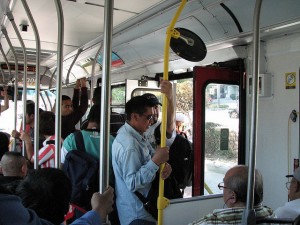 Ryan Reft at KCET looks at the history of the Bus Riders Union and the Los Angeles Metro, and how race and class issues have affected bus and rail transit:
Ryan Reft at KCET looks at the history of the Bus Riders Union and the Los Angeles Metro, and how race and class issues have affected bus and rail transit:
In 1992, the Labor/Community Strategy Center (LCSC), under the leadership of Eric Mann and Manuel Criollo, formed the Bus Rider’s Union, a project aimed at drawing attention to the class and racial inequality at the heart of MTA transit policy. Both Mann and Criollo came to realize the impact of these inequities through their work fighting environmental racism for LCSC. While trying to organize residents in and around Los Angeles County they kept encountering the same issue: their constituents worried about local oil refineries and air pollution, but what impacted even more directly was their two to three hour commutes to work from places like Wilmington to the Valley or Los Angeles. “That was a transformative moment for us,” reflected Criollo years later. “The buses would have forty people sitting and forty people standing, no air conditioning, completely messed up … And on Metrolink, people were riding like Disneyland.”
The litigation risk for Metro’s rail transit program has faded since the 1990s, due to an intervening Supreme Court case that makes suing over discrimination harder. But the moral and economic case for prioritizing low-income transit riders remains. One easy step for Metro to address these challenges would be to lower bus fares. It’s a great way to boost ridership and help the people who truly need it.
Even without litigation, the racial and class dynamics will continue to affect Metro decision-making, particularly as economic inequality persists and worsens.
Leave a Reply
You must be logged in to post a comment.


